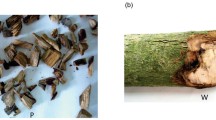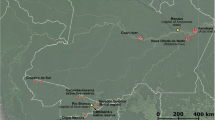Abstract
The work reported here investigated the fungal community inhabiting western redcedar fence material with a focus on species colonizing wood below the surface, of which little is known. From seven pieces of fence material, twenty-three different fungal species were isolated and characterized using both traditional morphology and molecular identification methods. The species identified included thirteen ascomycetous and ten basidiomycetous fungi. Isolates were tested for their resistance to β-thujaplicin - one of the principle fungicidal agents of western redcedar heartwood extractives. Generally, ascomycetous fungi exhibited greater resistance to β-thujaplicin than basidiomycetous fungi. Interestingly, three ascomycetous and two basidiomycetous species frequently isolated had high tolerance to this compound. These species could be candidate ’pioneer’ species that invade and detoxify western redcedar extractives, paving the way for colonization by decay fungi.
Similar content being viewed by others
References
T.R. Allen T. Millar S.M. Berch M.L. Berbee (2003) ArticleTitleCulturing and direct DNA extraction find different fungi from the same ericoid mycorrhizal roots New Phytologist 160 255–272 Occurrence Handle1:CAS:528:DC%2BD3sXot1Wiur4%3D
Y. Arima Y. Nakai R. Hayakawa T. Nishino (2003) ArticleTitleAntibacterial effect of beta-thujaplicin on staphylococci isolated from atopic dermatitis: relationship between changes in the number of viable bacterial cells and clinical improvement in an eczematous lesion of atopic dermatitis J. Antimicrobial Chemotherapy 51 113–122 Occurrence Handle1:CAS:528:DC%2BD38XpslOgsLk%3D
J.A. Arx von (1981) The genera of fungi sporulating in pure culture J. Cramer Vaduz, Germany
H.L. Barnett B.B. Hunter (1987) Illustrated genera of imperfect fungi Macmillan Inc. New York, USA
G.L. Barron (1962) ArticleTitleNew species and records of Oidiodendron Can. J. Bot. 40 589–607 Occurrence Handle10.1139/b62-125
J.A. Butcher (1968) ArticleTitleThe ecology of fungi infecting untreated and preservative treated sapwood of Pinus radiata Can. J. Bot. 46 1577–1589 Occurrence Handle10.1139/b68-219
J.W. Carmichael W.B. Kendrick I.L. Conners L. Sigler (1980) Genera of Hyphomycetes The University of Alberta Press Edmonton, Canada.
T.R. Cech (1988) ArticleTitleConserved sequences and structures of Group I introns: building an active sites for RNA catalysis Gene 73 259–271 Occurrence Handle10.1016/0378-1119(88)90492-1 Occurrence Handle1:CAS:528:DyaL1MXhsVyku7o%3D Occurrence Handle3072259
C.G.C. Chesters (1950) ArticleTitleOn the succession of microfungi associated with the decay of logs and branches Trans. Lincs. Natl. Union 12 129–135
Clubbe C.P. and Levy J.F. 1977. Isolation and identification of the fungal flora in treated wood. Revised technique. International Research Group on Wood Preservation Document No. IRG/WP/159.
G.T. Cole B. Kendrick (1973) ArticleTitleTaxonomic studies of Phialophora Mycologia 65 661–688
N.H. Corbett J.F. Levy (1963) ArticleTitleEcological studies on fungi associated with wooden fence posts Brit.Wood Pres. Assoc. News Sheet No. 27 1–3
K.H. Domsch W. Gams T.H. Anderson (1980) Compendium of soil fungi, Vols. I and II Academic Press New York, USA
B. Dujon (1989) ArticleTitleGroup I introns as mobile genetic elements: facts and mechanistic speculations - a review Gene 82 91–114 Occurrence Handle2555264 Occurrence Handle1:CAS:528:DyaL1MXmtV2kurg%3D
C.G. Duncan (1960) Wood-attacking capacity and physiology of soft-rot fungi, Report No. 2173 U.S. For. Prod. Lab. Madison, USA
R.A. Eaton M.D.C. Hale (1993) Wood Decay Pests and Protection.Chapman and Hall London, UK
M.B. Ellis (1971) Dematiaceous Hyphomycetes. Comm. Mycol. Inst. Kew Surrey England, UK
H. Erdtman J. Gripenberg (1948) ArticleTitleAntibiotic substances from the heartwood of Thuja plicata Don Nature 161 719 Occurrence Handle1:CAS:528:DyaH1cXjtF2rtw%3D%3D Occurrence Handle18860272
W.E. Eslyn (1970) ArticleTitleUtility poles decay Part II. Basidiomycetes associated with decay in poles. Wood Sci. Tech. 4 91–103
W.E. Eslyn T.H. Highley (1976) ArticleTitleDecay resistance and susceptibility of sapwood of fifteen tree species Phytopathol. 66 1010–1017 Occurrence Handle10.1094/Phyto-66-1010
W.P.K. Findlay (1966) ArticleTitleEcology of wood-destroying and wood-inhabiting fungi Material u. Organismen Beih. 1 199–211
W. Gams (2000) ArticleTitlePhialophora and some similar morphologically little-differentiated anamorphs of divergent ascomycetes Stud. Mycol. 45 187–199
M. Gardes T.D. Bruns (1993) ArticleTitleITS primers with enhanced specificity for basidiomycetes-application to the identification of mycorrhizae and rusts Mol. Ecol. 2 113–118 Occurrence Handle8180733 Occurrence Handle1:CAS:528:DyaK3sXlslOmsro%3D
R.L. Gilbertson (1974) Fungi that decay ponderosa pine Univ. Arizona Press Tucson, USA
Ginns J.H. (1986). Compendium of plant disease and decay fungi in Canada 1960-1980. Agric. Canada, Publ. No. 1813.
T.R. Horton T.D. Bruns (2001) ArticleTitleThe molecular revolution in ectomycorrhizal ecology: peeking into the black-box Mol. Ecol. 10 1855–1871 Occurrence Handle11555231 Occurrence Handle1:CAS:528:DC%2BD3MXmslyhtr8%3D
Hunt J., Boddy L., Randerson P.F. and Rogers H.J. 2004. An evaluation of 18S rDNA approaches for the study of fungal diversity in grassland soils. Microbial Ecology. in press
Y. Inamori S. Shinohara H. Tsujibo T. Okabe Y. Morita Y. Sakagami Y. Kumeda K. Ishida (1999) ArticleTitleAntimicrobial Activity and metalloprotease inhibition of hinokitiol-related compounds, the constituents of Thujopsis dolabrata S. and Z Hondae Mak. Biol. Pharm. Bull 22 990–993 Occurrence Handle1:CAS:528:DyaK1MXmtFCmt7s%3D
Y. Inamori Y. Sakagami Y. Morita M. Shibata M. Sugiura Y. Kumeda T. Okabe H. Tsujibo K. Ishida (2000) ArticleTitleAntifungal Activity of hinokitiol-related compounds on wood-rotting fungi and their insecticidal activities Biol. Pharm. Bull. 23 995–997 Occurrence Handle10963310 Occurrence Handle1:CAS:528:DC%2BD3cXlsFamsL0%3D
Jin L. (1987). Detoxification of Thujaplicins in living western red cedar (Thuja plicata Donn.) PhD Thesis, University of British Columbia, Canada
L. Jin B.J. Vander Kamp J. Wilson E.P. Swan (1988) ArticleTitleBiodegradation of thujaplicins in living Western Red Cedar Can. J. For. Res. 18 782–786 Occurrence Handle1:CAS:528:DyaL1cXlsVKntLg%3D
A. Käärik (1980) ArticleTitleFungi causing sap stain in wood The Swedish University of Agricultural Science. Report Nr. R. 114 112
G. Kernaghan L. Sigler D. Khasa (2003) ArticleTitleMycorrhizal and root endophytic fungi of containerized Picea glauca seedlings assessed by rDNA sequence analysis Microbiol Ecology 45 128–136 Occurrence Handle1:CAS:528:DC%2BD3sXhvVyru7s%3D
B.R. Kropp M.E. Corden (1986) ArticleTitleMorphology and taxonomy of Pachnocybe ferruginea Mycologia 78 334–342
J.S. Lee K.S. Ko H.S. Jung (2000) ArticleTitlePhylogenetic analysis of Xylaria based on nuclear ribosomal ITS1-5.8-ITS2 sequences. FEMS Microbiol. Lett. 187 89–93 Occurrence Handle10828406 Occurrence Handle1:CAS:528:DC%2BD3cXjsVGitL0%3D
P.A. Lemke (1964) ArticleTitleThe genus Aleurodiscus (sensu stricto) in North America Can. J. Bot. 42 213–282 Occurrence Handle10.1139/b64-021
H MacLean J.A.F. Gardner (1956) ArticleTitleDistribution of fungicidal extractives (thujaplicin and water soluble phenols) in western redcedar heartwood For. Prod. J. 6 510–516
D.J. McLaughlin M.E. Berres L.J. Szabo (1995) ArticleTitleMolecules and morphology in Basidiomycete phylogeny Can. J. Bot. 73 IssueID(Suppl. 1 S684–S692 Occurrence Handle1:CAS:528:DyaK28XjsVOq
D.S. Meredith (1960) ArticleTitleFurther observations on fungi inhabiting pine stumps Ann. Bot. 24 63–78
M. Monreal S.M. Berch M. Berbee (1999) ArticleTitleMolecular diversity of ericoid mycorrhizal fungi Can. J. Bot. 77 1580–1594 Occurrence Handle1:CAS:528:DC%2BD3cXhvVyisbw%3D
R.T. Moore (1987) ArticleTitleMicromorphology of yeasts and yeast-like fungi and its taxonomic implications Stud. Mycol. 30 203–226
J.J. Morrell C.M. Freitag C. Eddington (2001) ArticleTitleEffect of preservative treatment on survival of fungi in Western Red Cedar utility poles For. Prod. J. 59 69–72
K.K. Nakasone (1990) ArticleTitleCultural studies and identification of woodinhabiting Corticiaceae and selected Hymenomycetes from North America Mycol. Mem. 15 1–412
Nault J. (1986). Radial distribution of thujaplicins and thujic acid in old growth and second growth Wester Red Cedar. MSc. Thesis, University of British Columbia, Canada.
M.K. Nobles (1965) ArticleTitleIdentification of cultures of wood inhabiting Hymenomycetes Can. J. Bot. 43 1097–1139
F. Oberwinkler R.J. Bandoni (1982) ArticleTitleA taxonomic survey of the gasteroid, auricularioid heterobasidiomycetes Can. J. Bot. 60 1726–1750
E. Rennerfelt (1948) ArticleTitleInvestigations of thujaplicin, a fungicidal substance in the heartwood of Thuja plicata D. Don. Physiologia Palntarum 1 245–254 Occurrence Handle1:CAS:528:DyaH1MXhvVektg%3D%3D
T.C. Scheffer B.S. Goodell F.F. Lombard (1984) ArticleTitleFungi and decay in western redcedar utility poles Wood Fiber Sci. 16 543–548
M.B. Schol-Schwarz (1970) ArticleTitleRevision of the genus Phialophora (Moniliales) Persoonia 6 59–94
A.L. Shigo (1967) ArticleTitleSuccession of organisms in discoloration and decay of wood Int. Rev. For. Res. 2 237–299
R.S. Smith D.W. Swan (1975) ArticleTitleColonisation of western red cedar shingles and shakes by fungi Material u. Organismen Beih. 3 253–262
J.A. Stalpers (1978) ArticleTitleIdentification of wood-inhabiting fungi in pure culture Stud. Mycol. 16 1–248
L. Tedersoo U. Kõljalg N. Hallenberg K.-H. Larsson (2003) ArticleTitleFine scale distribution of ectomycorrhizal fungi and roots across substrate layers including coarse woody debris in a mixed forest New Phytologist 159 153–165 Occurrence Handle1:CAS:528:DC%2BD3sXlslalt7s%3D
T.J. Trust R.W. Coombs (1973) ArticleTitleAntibacterial activity of β-thujaplicin Can. J. Microbiol. 19 1341–1346 Occurrence Handle4588652 Occurrence Handle1:CAS:528:DyaE2cXnvVOgtQ%3D%3D Occurrence Handle10.1139/m73-216
B.J. Van der Kamp (1975) ArticleTitleThe distribution of microorganism associated with decay of western redcedar Can. J. For. Res. 5 61–67
W.F. Walker (1984) ArticleTitle5S rRNA sequences from Atractiellales, and basidiomycetous yeasts and fungi imperfecti Syst. Appl. Microbiol. 5 352–359 Occurrence Handle1:CAS:528:DyaL2MXhtVygtrY%3D
C.J.K. Wang (1965) Fungi of pulp and paper in New York State Univ. Coll. For. Tech. Pub. 87. Syracuse New York, USA
C.J.K. Wang R.A. Zabel (1990) Identification manual for fungi from utility poles in the eastern united states Allen Press Inc. Lawrence, KS, USA.
Warren G.R. and Marshall J.W. 1986. Newfounland and Labrador hydroutility pole study II. Fungi isolated from treated transmission utility poles of the Avalon Penisula. Canadian Forestry Service, St. John’s, Newfoundland, file report: Study 2760-95.
J.D. Wethern (1959) ArticleTitlePulp and chemical potential for western red cedar utilization For. Prod. J. 9 308–313
T.J. White T.D. Bruns S.B. Lee J.W. Taylor (1990) Amplification and direct sequencing of fungal ribosomal RNA genes for phylogenetics M.A. Innis D.H. Gelfand J.J. Sninisky T.J. White (Eds) PCR protocols: a guide to methods and applications. Academic Press New York 315–322
S.G.R. Wirsel W. Leibinger M. Ernst K. Mendgen (2001) ArticleTitleGenetic diversity of fungi closely associated with common reed New Phylologist 149 589–598 Occurrence Handle1:CAS:528:DC%2BD3MXis1ansL8%3D
C. Yu T.E.J- K.N. Egger R.L. Peterson (2001) ArticleTitleEctendomycorrhizal associations-characteristics and functions Mycorrhiza 11 167–177 Occurrence Handle10.1007/s005720100110 Occurrence Handle1:CAS:528:DC%2BD3MXmt1agsL4%3D
R.A. Zabel F.F. Lombard C.J.K. Wang F. Terracina (1985) ArticleTitleFungi associated with decay in treated southern pine utility poles in the eastern United States Wood Fiber Sci. 17 75–91 Occurrence Handle1:CAS:528:DyaL2MXht1OisLo%3D
Author information
Authors and Affiliations
Corresponding author
Rights and permissions
About this article
Cite this article
Lim, Y.W., Kim, JJ., Chedgy, R. et al. Fungal diversity from western redcedar fences and their resistance to β-thujaplicin. Antonie Van Leeuwenhoek 87, 109–117 (2005). https://doi.org/10.1007/s10482-004-1729-x
Received:
Accepted:
Issue Date:
DOI: https://doi.org/10.1007/s10482-004-1729-x




